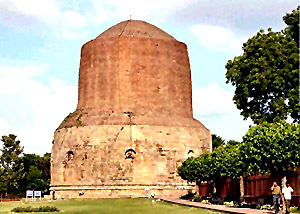 The classical era in regard to architecture, literature, art and sculpture, the Gupta period also mirrored the authentic aura of Hinduism in the true sense of the term. Although Hinduism prevailed yet Gupta era was also famous for those imposing Buddhist architecture. Buddhism was somewhat overshadowed by Hinduism that was prevailing at that era yet the very essence of Buddhism was felt amidst the stupa , monasteries and in the midst of several Buddhist temples.
The classical era in regard to architecture, literature, art and sculpture, the Gupta period also mirrored the authentic aura of Hinduism in the true sense of the term. Although Hinduism prevailed yet Gupta era was also famous for those imposing Buddhist architecture. Buddhism was somewhat overshadowed by Hinduism that was prevailing at that era yet the very essence of Buddhism was felt amidst the stupa , monasteries and in the midst of several Buddhist temples.
Stupas: Stupa has been found at Jaulian Charasadda and other ancient site or Pushakalavati. One of the two stupas at Jarasandha-Ka-Baithak in Rajir and Dhamekh Stupa at Sarnath belong to the end of our period. The Dhamekh stupa is 128 feet in height and has 4 inches at the four cardinal points for Buddha images. The scrollwork on this stupa has evoked just praise and the structure is also remarkable for the variety of geometric patterns with which part of its area has been covered.
Monasteries: Monasteries have been found at ancient sites near Pushakalavati. At Mehra Maradu there were an assembly hall dining-hall, kitchen, storeroom, bathroom and latrine, associated with a religious establishment. The Sarnath excavations have unearthed the remnants of a Buddha temple and a number of monasteries. The monasteries consisted of a number of rooms around a courtyard, sometimes had chapels of their own.
Brick temple: Narasimha-gupta Baladitya built a magnificent brick temple of the Buddha at Nalanda. It was 300 feet in height and evoked admiration of Chinese travelers. This majestic structure has now entirely disappeared.



















